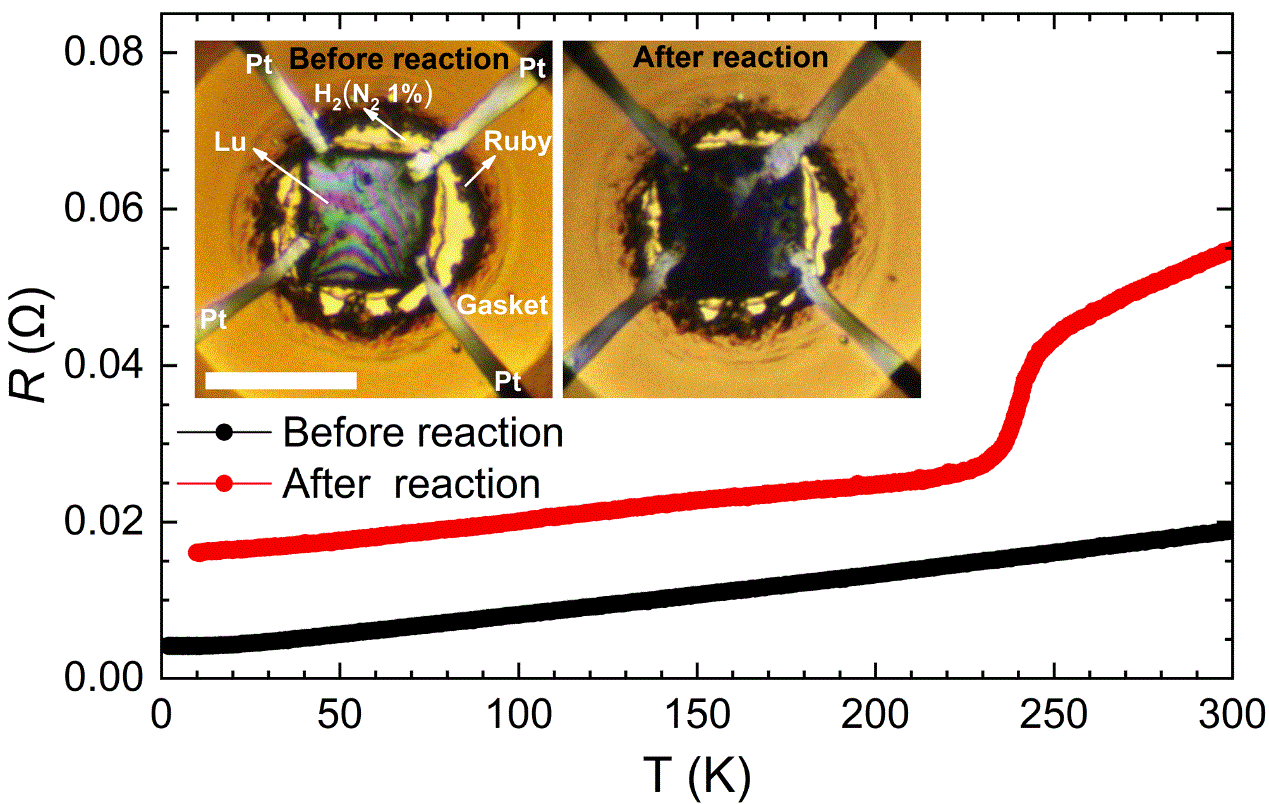Recently, a research team led by Drs. Qiaoshi Zeng and Ho-kwang Mao from Center for High Pressure Science and Technology Advanced Research (HPSTAR) repeatedly reproduced the near-room temperature resistance transition in the reaction products (Lu-H-N) of Lu with hydrogen-nitrogen mixture by employing in-situ high-pressure four-probe electrical transport measurement technique to monitor the entire reaction process under different conditions (pressure, temperature, and time). With this reliable experimental protocol, they explicitly reveal that the near-room temperature resistance transition in the Lu-H-N did not result in zero resistance, nor did it exhibit magnetic suppression, ruling out the possibility of any superconductivity. Instead, the resistance transition is suggested to be related to an order-to-disorder transition of hydrogen octahedral vacancies in non-stoichiometric lutetium hydrides, which leads to a metal-to-semiconductor/insulator transition with drastic resistance change. This study overturns the sensational "near-room temperature superconductivity" phenomenon in the Lu-H-N system. The related findings, titled "Origin of the near-room temperature resistance transition in lutetium with H2/N2 gas mixture under high pressure," were published in a recent issue of the National Science Review.
In 1911, Dutch physicist Prof. Heike Kamerlingh Onnes discovered that when mercury was cooled to below 4 K, it exhibited zero resistance—a phenomenon known as superconductivity. Since then, superconductivity has aroused great interest in the scientific and industrial communities as a novel quantum condensed matter phenomenon with widespread applications. Over the past century, breakthroughs related to superconductivity have produced ten Nobel Physics Prize laureates, including Heike Kamerlingh Onnes, but scientists have never stopped pursuing superconducting materials with higher transition temperatures to enable broader applications without the need for cooling. In March 2023, Dias et al. reported in Nature a compound produced by the reaction of lutetium with a hydrogen-nitrogen gas mixture, exhibiting superconductivity near room temperature under near-ambient pressure conditions. This discovery suggested the possibility of opening a new era of "room temperature superconductivity," triggering rapid global attention and prompt follow-up research. However, unfortunately, no research team has been able to independently replicate Dias et al.'s results, leading to widespread controversy and skepticism. The Wall Street Journal, Science, and Nature News have been tracking this field for several months, which raised questions about integrity of Dias et al., but the key scientific issue was believed to be the direct experimental clarification of whether the Lu-H-N compound system exhibits zero-resistance superconducting characteristics.
Drs. Qiaoshi Zeng and Ho-kwang Mao from HPSTAR approached the problem at its core. The team designed an in-situ four probe circuit to monitor the entire reaction process of pure metal lutetium with hydrogen-nitrogen gas mixture in real-time. They found that the reaction was highly sensitive to reaction pressure, temperature, and time. By controlling the reaction parameters, they were able to highly repeatedly reproduce the resistance transition of the reaction product near room temperature (Fig.1). However, this transition did not result in zero resistance but rather higher resistance values than pure metal lutetium, indicating a deterioration in the sample's conductivity. The research team further found that the near-room temperature resistance transition did not exhibit the magnetic field suppression characteristic of superconductors. Therefore, the drastic change observed in resistance was a transition from metal to poor conductor, rather than a superconducting transition.
Furthermore, the research team used transmission electron microscopy to characterize the structure of the samples with resistance transitions, revealing typical modulated structures caused by hydrogen octahedral occupancy or vacancies. Such structures have been reported in other non-stoichiometric light rare-earth hydrides accounting for a reversible order-to-disorder phase transition of hydrogen octahedral vacancies with temperature changes. This kind of structural transition leads to a metal-to-semiconductor or insulator phase transition near room temperature, accompanied by a resistance transition. These findings emphasize the important role played by hydrogen vacancy defects in non-stoichiometric reaction products due to insufficient reaction, providing a microstructural mechanism for the near-room temperature resistance transition in lutetium hydride (nitrogen doped) compounds. It also illustrates the importance of controlling the extent of the reaction and explains the possible reasons why other researchers have had difficulty replicating the experimental results. In addition, the study clarified that the color change and resistance transition reported by Dias et al. were not necessarily related.
This work reveals the origin of the near-room temperature resistance transition in lutetium-hydrogen (nitrogen-doped) systems, ruling out room-temperature superconductivity and putting an end to the controversy and debates. The method proposed by this study to monitor the reaction process under high pressure in real-time through in-situ four-probe electrical transport technique can also be applied to the precise control of the synthesis of other high-pressure hydrides and the reactions of other gases and solids under high pressure, providing a new method for studying high-pressure superconducting materials.
The leading author of this work is Peng Di, a doctoral student of HPSTAR. The corresponding authors are Drs. Qiaoshi Zeng and Ho-kwang Mao. Co-authors include Drs. Ding Yang, Zhidan Zeng, doctoral students of HPSTAR Fujun Lan and Zhenfang Xing, as well as Prof. Xiaohang Ke from Beijing University of Technology. This work was funded by the Shanghai Science and Technology Commission (22JC1410300 and 22dz2260800).

Caption: In situ electric resistance measurements for the Lu foil sample loaded with H2/N2 gas mixture in a diamond anvil cell at 10 GPa and 295 K. The insets are the optical microphotographs of the Lu foil sample just loaded (left) and after a 5-days reaction (right) with four Pt electrodes and H2/N2 gas mixture in a diamond anvil cell at 10 GPa and 295 K. The black and red curves are temperature dependent raw resistance values during warming from 2 K (10 K) to 300 K for the initial pure Lu metal before reaction and the same sample after reaction for 5 days at 10 GPa and 295 K, respectively. This figure is from https://doi.org/10.1063/5.0166430.
近日,北京高压科学研究中心(HPSTAR)曾桥石和毛河光研究员带领的研究团队,设计了一种集成“金属氢化物高压合成”与“电输运原位测量”的一体化实验方案,并将该方法成功用于镥-氢-氮(Lu-H-N)体系的研究。他们在金属镥与氢-氮混合气体在高压下反应的相对早期阶段高度可重复地观测到了近室温的电阻突变,并且通过一系列的电、磁和结构研究,首次澄清了这一电阻突变是和材料中氢空位发生的无序-有序转变有关的金属到不良导体的转变,而非之前在国际上引起轰动的“室温超导转变”。相关成果以“Origin of the near-room temperature resistance transition in lutetium with H2/N2 gas mixture under high pressure”为题,在线发表于近期的《国家科学评论》上。
